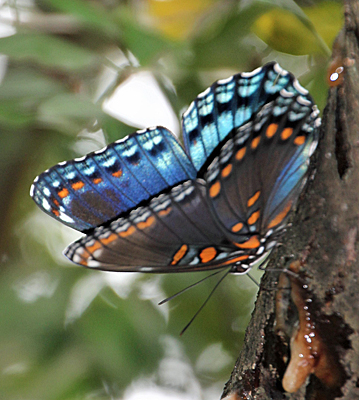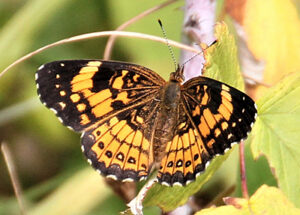By Anne Ellis
Butterfly Count Coordinator
This year marked the Loudoun Wildlife Conservancy’s 25th annual butterfly count. Twelve teams were deployed throughout the count circle to peer into every bush and roadside ditch, scrutinize every blossom they could find, peek around trees and buildings and stroll through lush plantings in search of our favorite insect.

Red-spotted Purple butterfly.
Photo by Bob DeWitt
Prior to the count many of us thought that we were seeing fewer butterflies than usual. However, the count data shows that flight was above average this year. We counted 4259 butterflies in 48 species. The 5-year average is 3683 butterflies, 48 species. A Giant Swallowtail (Papilio cresphontes) sighted by the Purcellville Team was a clear highlight. We have seen this species just four other times.
With numbers like this, why do we feel like there are not as many butterflies as there used to be? Could our concerns about climate change be influencing our perceptions? The worrisome news of catastrophic loss of insects worldwide? Massive habitat loss? Our data doesn’t seem to support such concern. Perhaps there are other, more local factors, that might influence our perception of butterfly flight.
Let’s start with who is looking. A casual observer is looking for colorful fluttering around pretty flowers. A gardener who is more concerned with what’s eating precious plants and may suspect caterpillars (baby butterflies) to be the culprit. A lepidopterist, in focusing on a particular species, may overlook others. The big, showy Eastern Tiger Swallowtail, the busy and populous Cabbage White, and the more subtle Zabulon Skipper are all well represented in the data.
Perhaps it is when and where we look. Many garden-worthy natives, such as Monarda and Milkweed, were already out of season by the time of the count and a butterfly magnet like Common Thistle is usually weeded out of garden areas. In fact, many butterflies prefer those weedy patches and roadside ditches. Areas like this are often mowed according to a schedule based on human, not butterfly, requirements.

Silvery Checkerspot butterfly.
Photo by Bob DeWitt
Time of day, time of year and general weather conditions all impact butterfly flight patterns. If spring is delayed or early, caterpillar growth may be faster or slower (warm weather = speedy development). The result is slightly earlier or later flight of adult butterflies. Windy, cold, rainy weather drives them into hiding. Butterfly time is hot, sunny, humid, and not too breezy. If the weather does not cooperate on the day you happen to be making observations, the results may be disappointing.
If you want to see butterflies you must brave our typical summer weather, especially in August. And we invite you to do just that: the Loudoun Wildlife Conservancy’s 26th annual butterfly count will be on August 6, 2022. Please join us!

